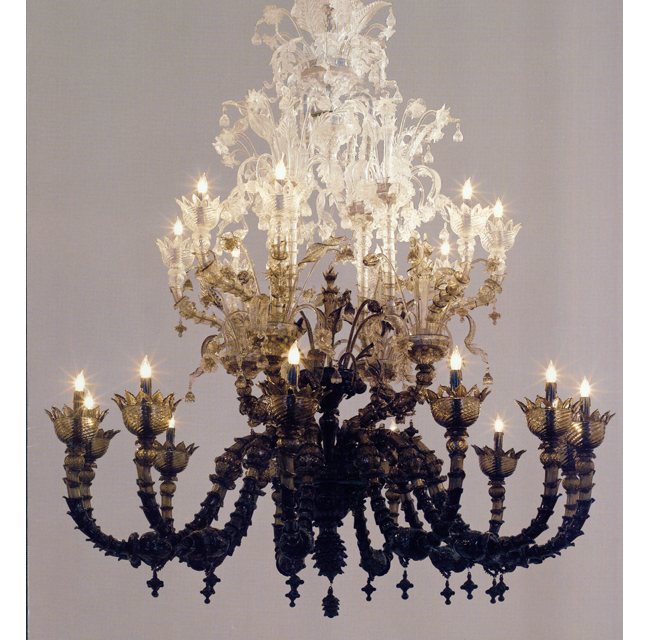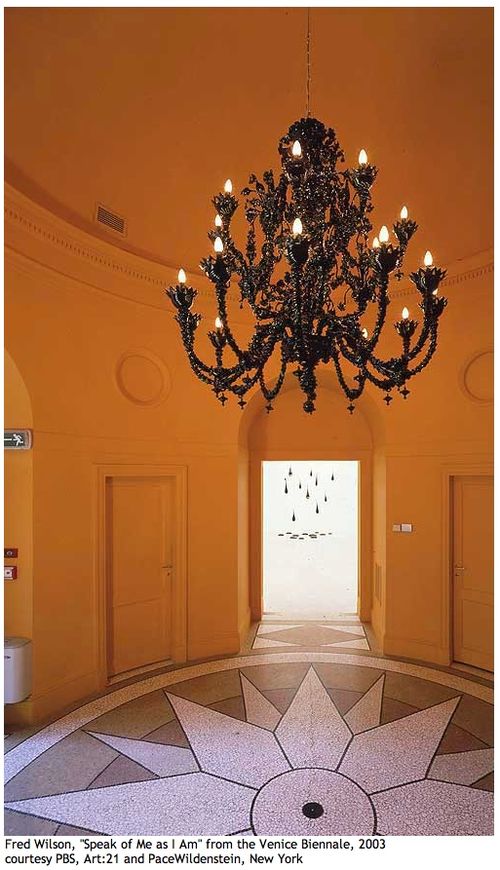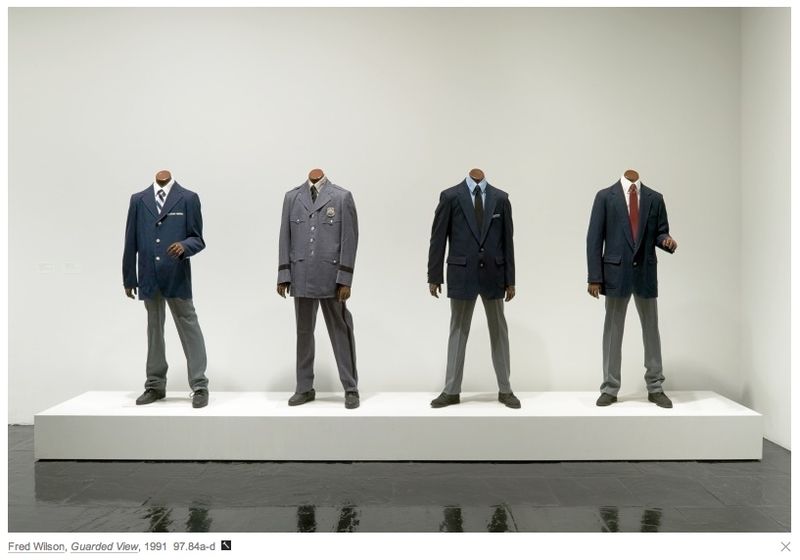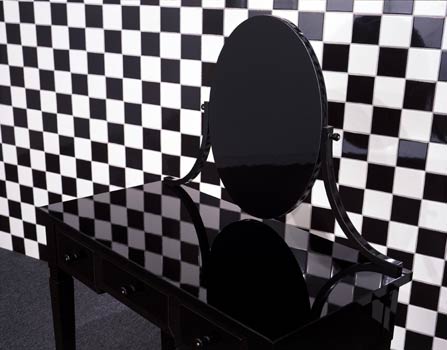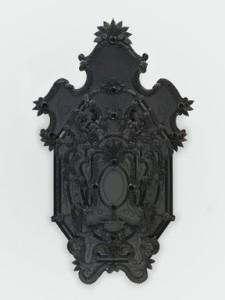
Fred Wilson is represented in many collections. One of them is the collection of The Brooklyn Museum, New York with this work.
Lago’s Mirror, 2009.
The Shock of the Familiar
Fred Wilson has an uncommon touch with common things. His art—and the discomfort it provokes—is in the context. Could be why the carabinieri didn’t quite get it at the opening of the fiftieth Venice Biennale, where he is America’s representative.
Phoebe Hoban
On the opening day of the fiftieth Venice Biennale last month, the sweltering space outside the U.S. Pavilion was transformed into a typical New York street scene: A swarm of agitated police descended on a Senegalese vendor and his table of faux designer handbags. Any minute they would haul him away. Or would they? As it turned out, the vendor was not a vendor at all, but a tourist enlisted by Fred Wilson, the American representative to the Biennale, whose work was displayed in the pavilion. And the bags weren’t Prada knockoffs but one-of-a-kind pieces Wilson had created from the same handmade fabric he’d used to costume the mannequins that were part of the installation. The visit by police was unplanned, but once again the artist had turned an ordinary tableau into something extraordinary.
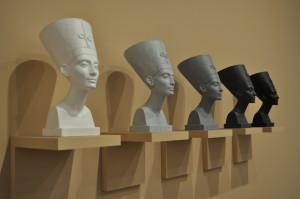 Grey Area (Black Version), 1993.
Grey Area (Black Version), 1993.
“The guy was the cousin of a friend,” Wilson says with a soft chuckle over lunch in Chelsea a few weeks later. He’s resplendent in a white Hermès suit and sorbet-yellow-and-white-striped seersucker shirt. “When the carabinieri came running over to drag him away, it made you stop and think about your initial reaction. It’s something you think you understand, but then you realize that there are other layers. He took it all in very good spirits; it took the police a little while to understand that it was art.”
They weren’t the only ones who didn’t get it. “A lot of people really had problems with the vendor and thought it was exploitation,” says Robin Cembalest, executive editor of ARTnews. “It was definitely one of the most talked-about and provocative aspects of the whole Biennale. Instead of just walking by this African in the street, you were forced not to ignore him. That was the whole point of the piece.”
Call it trompe l’oeil curating, a term Wilson coined for what could be described as meta-museology. Since 1992, when he created “Mining the Museum,” a watershed exhibition in Baltimore, Wilson has been making people uncomfortable with otherwise familiar objects—or their absence. Consider two pieces from that show that are included in a Wilson retrospective now at the University of Houston and scheduled to open at the Studio Museum in Harlem next April. In one, Wilson placed a Ku Klux Klan hood inside an Edwardian-era baby carriage, transmogrifying it into something horrifying. When it was first shown, Wilson says, the Maryland Historical Society called him to ask what to do with a school group that included some children with parents who were KKK members. “The image is charged by what you bring to it,” he says.
Another, equally powerful piece, Cabinetmaking, 1820–1960, juxtaposed a group of ornate nineteenth-century chairs with a crude whipping post used to hold slaves for beating; Wilson discovered all of the objects in the historical society’s archives. “ ‘Mining the Museum’ changed the way I understood what it meant to put objects in a public space,” says Thelma Golden, chief curator of the Studio Museum in Harlem.
In Venice, Wilson placed carved wooden “blackamoors”—black figurines in subservient poses found all over the city—in a museum-like setting; to make the image literally incendiary, he accessorized them with acetylene torches and fire extinguishers. The figures, Wilson observes, are so common in Venice that few people even notice them—exactly his point. “They are in hotels everywhere in Venice,” he says, “which is great, because all of a sudden you see them everywhere. I wanted it to be visible, this whole world which sort of just blew up for me.”
In a room tiled in black and white, the most famous Moor of all, Othello, retracts his murderous jealousy in a seven-minute continuous backward loop shown on four large flat-screen video monitors, accompanied by musical interpretations of the story, including Verdi’s Otello. “It’s the Desdemona scene, starting with their deaths and going back to when they were in love,” Wilson explains. “It’s trying to reverse history. It’s called September Dreams. I thought of it after September 11.”
Perhaps the most resonant work in the pavilion is its simplest: Wilson contracted the famed Murano glassmakers to create a traditional seventeenth-century chandelier in ebony-black glass. Hung in the entrance of the neoclassical pavilion, against yellow walls meant to evoke the gold-leaf chambers of St. Mark’s basilica, the chandelier could be a giant spider, or a black cloud of tears. “It definitely has a funereal feeling,” Wilson says.
“There’s a sadness that permeates Fred’s entire body of work,” says Maurice Berger, who curated the Wilson retrospective. “It is so much about what’s absent, what’s lost. He sees the museum as a kind of ruin. He opens up a wound and exposes areas that are hidden.”
Unlike most of the artists exhibited in Venice, Wilson created site-specific work, scavenging Venetian culture to construct a uniquely Wilsonian view of blacks, past and present, in the ancient city. Not everyone was a fan. In the Times, Michael Kimmelman called the installation “a big disappointment, obvious and overwrought.” Juan Puntes, director of White Box, an alternative space in Chelsea, described it as “ready-made to be dropped into Metro Pictures”—Wilson’s New York gallery. “Snide responses are typical of looking at work that doesn’t always speak in codes that are accepted,” says Golden. “I think Fred is an incredibly gifted cultural impresario.”
Born in the Bronx in 1954 to a Caribbean mother and an African-American father, Fred Wilson quickly got used to adapting to new environments. The family moved every five years, each time to a home designed by his mother, an art and music teacher. His father, now retired, was a civil engineer who supervised, among other projects, the building of the lower level of the George Washington Bridge.
Wilson spent most of his childhood in an all-white enclave in Westchester, where his family was greeted with racist graffiti—NIGERS [sic] GO BACK TO AFRICA—before they had even moved in. His parents divorced in 1962, although he often saw his father, who later married a Dutch woman and now lives in Europe. “I had very few friends,” Wilson says, “so I developed this whole world on my own, and I think that’s why I’m an artist. My work is definitely tinted by this experience.”
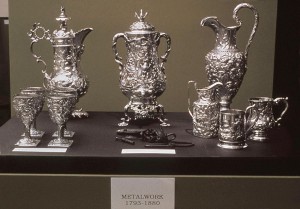 Mining the Museum, from 1992 on.
Mining the Museum, from 1992 on.
Wilson and his mother and sister returned to the Bronx after he finished grade school. He attended the LaGuardia High School of Music & Art and Performing Arts in Manhattan. He got his first glimpse of the museum world when he took art classes at the Metropolitan Museum, wandering after-hours into areas that the public never saw. At SUNY Purchase, from which he graduated in 1976, he studied performance art and dance and worked at the campus’s Neuberger Museum as a guard.
In the late seventies, Wilson worked as an art installer, curator, freelance teacher, administrator, and guard at most of the city’s major museums. “Working in the education department at the Met and at the Museum of Natural History, I was very aware of what wasn’t being shown to the public,” he recalls. “Those were the experiences that really got me thinking.”
In 1987, he got a chance to put his insider’s knowledge to work when he became the director of the Longwood Arts Project, an alternative space in the South Bronx. One show, “Rooms With a View,” played with the notion of the installation space itself by placing a trio of emerging artists in three different settings: a contemporary gallery, a turn-of-the-century space, and a small ethnographic museum—where the artists’ work was identified not with their names but with generic history-oriented museum-style labels (e.g., FOUND, WILLIAMSBURG SECTION, BROOKLYN, LATE 20TH CENTURY). The deceptively simple juxtaposition of art objects, display space, and institutional labels became a template for much of Wilson’s later work. “I sort of go outside the museum and tell people what the museum is trying to tell them,” he says. In recognition of his unique vision, the MacArthur Foundation awarded him a “genius” grant in 1999.
On a sizzling day in early July, Wilson opens the door to the rambling East Village loft he shares with his partner of 22 years, artist Whitfield Lovell. Wilson’s curatorial curiosity is in evidence everywhere—from the ceramic pots and globes he collects, to the neatly arranged bars of novelty soaps in the bathroom ironically labeled white men, to the taxidermic display of birds. The two men share a powerful acquisition habit: Lovell collects tintypes, Cuban art, Mexican retablos, and all sorts of hands. “It reflects the interior of both of our minds,” says Wilson of the loft.
 Mining the Museum, from 1992 on.
Mining the Museum, from 1992 on.
But changes are afoot. Wilson has just converted a small building in Williamsburg into a studio that, he says, is “the exact opposite of this space.” Triumphantly, he leads a small posse—his assistant, Gloria, and me—into Brooklyn to check it out. It is pristine, the equivalent of a blank white page. With its garage-style glass-paned door, it looks like a minimalist gallery. But it won’t take Wilson long to turn it into an elaborate alternate reality. “My studio is in my head,” he says. Art is in the cleverly culled details.
(Essay was published in New York Magazine)
Courtesy: Pace Gallery New York

